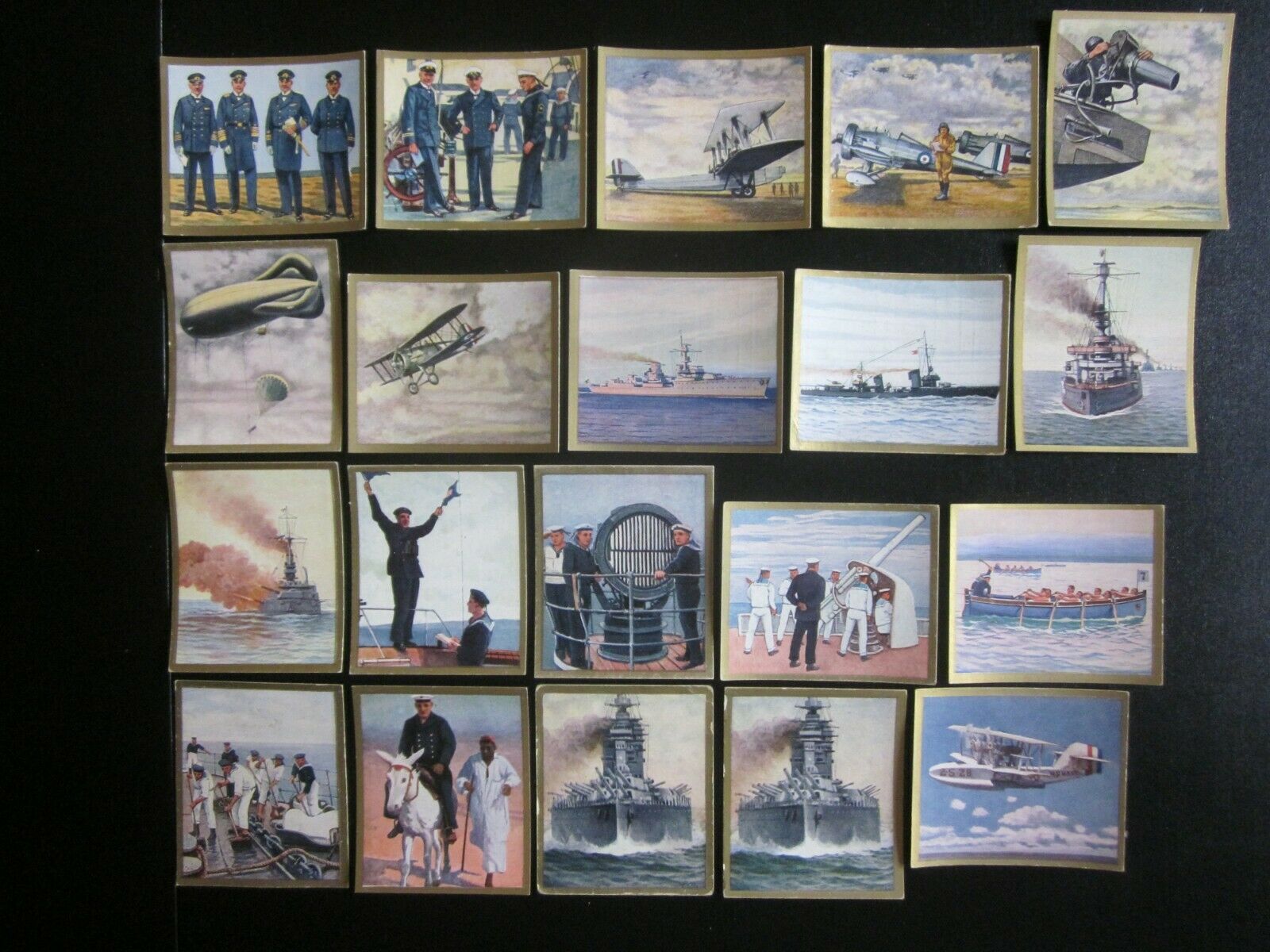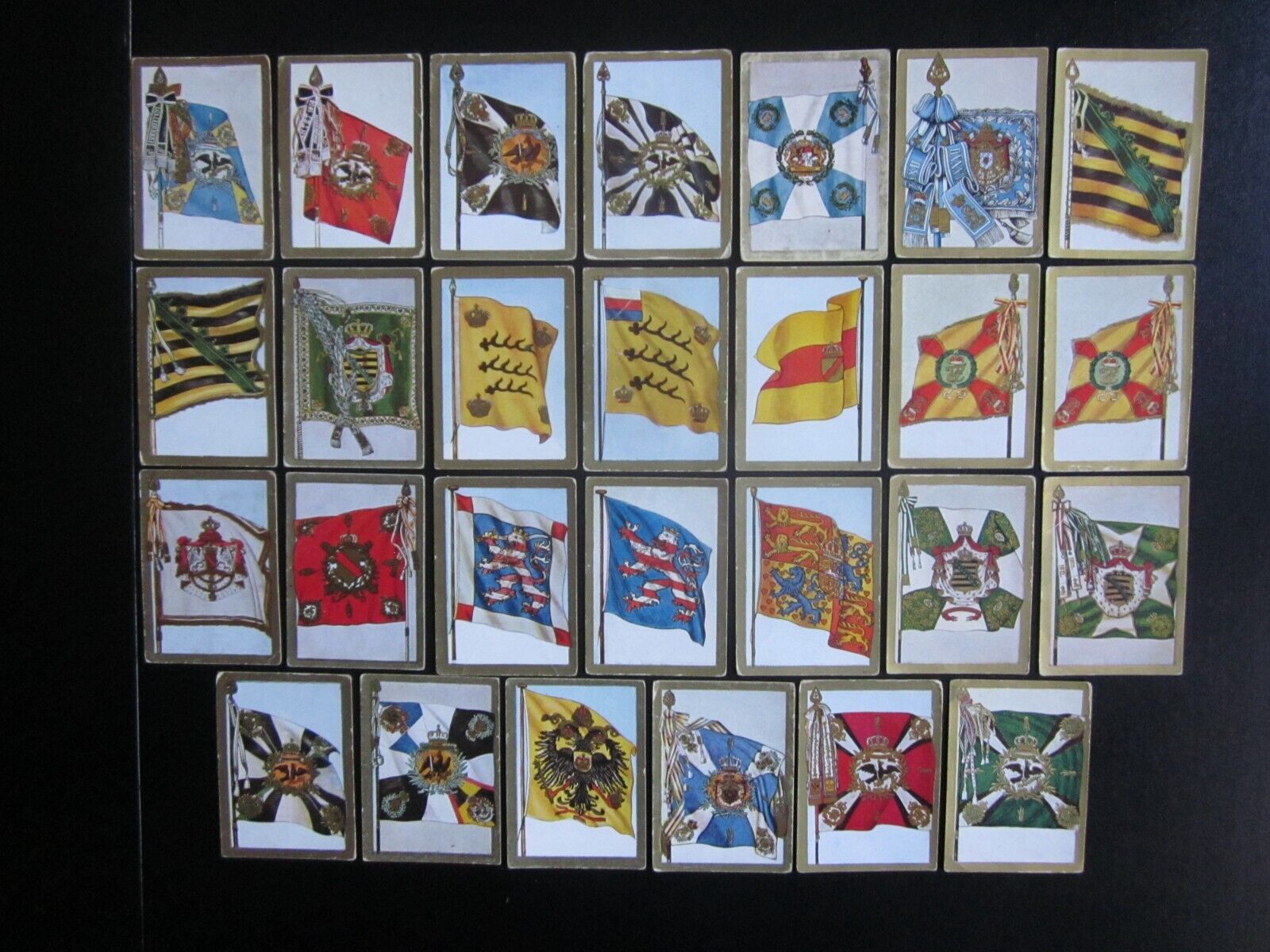-40%
20 color German cig. cards: German Military (warships, warplanes), issued 1933
$ 3.43
- Description
- Size Guide
Description
Offered here are 20 original German cigarette cards (one double) of the German Military in the early 1930s, issued in 1933 by the Waldorf-Astoria Cigarette Co. and the Haus Neuerburg Cigarette Co. for the albumDie Reichswehr
(The German Military). Pictured here are:
No. 2:
Naval Officers. Admiral, Vice-Admiral, Rear-Admiral are the ranks of the flag officers in the navy. Captain, Frigatte-Captain and Corvette-Captain constitute the staff officers, while the Lieutenant Captain is a class unto itself.
No. 3:
The Next Generation of Officers. Our small navy can only accommodate a few of the many qualified applicants for training candidates for the positions of Sea Officer, Engineering Officer, Medical Officer and Bursar Officer.
No. 212:
A Heavy Bomber. Modern day-and-night bombers can carry loads of 2,000 to 3,000 kilos of bombs and have a range of 1,000 to 1,500 kilometers. Therefore, all of Germany can be reached from every direction by these machines.
No. 213:
The Single-Seat Fighter Plane. Single-seat fighters are the best weapon for fending off air attacks. Unfortunately, Germany is not permitted to have any such aircraft. Most modern fighter now come equipped with six machine guns, high climbing ability, a range of 2 to 3 hours flight and a speed of 350 kilometers per hour.
No. 213:
The Single-Seat Fighter Plane. Single-seat fighters are the best weapon for fending off air attacks. Unfortunately, Germany is not permitted to have any such aircraft. Most modern fighter now come equipped with six machine guns, high climbing ability, a range of 2 to 3 hours flight and a speed of 350 kilometers per hour.
No. 216:
Photos from the Air. Pilots and their cameras are today the eyes of the army commanders on the ground, because they can go far behind enemy lines and take pictures.
No. 217:
Tethered Balloons. Despite the development of military airplanes, tethered balloons are still very important for artillery spotting and recon. However, Germany is not permitted to own any such balloons by the Versailles Treaty.
No. 223:
Artificial Fog from an Airplane. Through the use of artificial fog distributed by airplanes one can conceal buildings or entire blocks of buildings from the eyes of enemy airplanes.
No. 249:
“Leipzig”-Class Cruisers. This new class of cruiser is armed with nine 15-cm guns, four 8.8-cm guns and twelve 50-cm torpedo tubes. It displaces 6,000 tons and generates 65,000 HP and can reach a speed of 32 knots.
No. 250:
Our New Torpedo Boats. These new boats are equipped with three 10.5-cm guns and six 50-cm torpedo tubes. They displace 800 tons and generate 28,000 HP and can reach a top speed of 34 knots.
No. 257:
the Keel Line. The training of new sailors and officers concludes each year with maneuvers in which all ships and squadrons take part.
No. 258:
Artillery Practice. A battle at sea will usually be determined by the ability of a fleet’s ships and crews to best utilize their artillery. A gunner has to train with a rifle first, before he can graduate to smaller caliber cannons and then the larger ones.
No. 261:
Semaphore. Radio communications are not always the fastest and best way to communicate during a battle. That is why signaling with flags is still in use.
No. 262:
Spotlights. Night fighting puts many challenges before gun crews who have to stay at their guns for long periods of time. The spotlight helps to illuminate the situation and is considered the eyes of the ship in the darkness.
No. 266:
Air Defense. The airplane is a dangerous weapon, even at sea. For that reason, Flak-guns and machine guns are being added to most warships.
No. 270:
A Rowing Regatta. The navy encourages sailing and rowing sports among its sailors. Every year there is a fleet regatta. The winners qualify for the Marine Championships which are held every three years.
No. 271:
Swabbing the Deck. In the close quarters of a warship order and cleanliness are a basic necessity. Every sailor is well familiar with the daily duties to keep the ship in good order.
No. 272:
Exploring the World. Our “Boys in Blue”, the sailors of the German Navy, enjoy exploring new lands when they dock in foreign harbors.
No. 276 [2x]:
The British Battleship "Nelson". 28-cm guns are the biggest allowed on German warships. However, other European nations regularly have 30-, 34.5-, 38- and even 40-cm guns on their ships. The British battleship "Nelson" is just such a Goliath (35,000 tons displacement).
No. 279:
A Sea-Plane. Deprived of sea-planes and airships by the Versailles Treaty, our fleet has virtually no reconnaissance abilities. Foreign sea-planes can be found all over the seas and many of them even carry their own torpedo.
On the back of each card at the bottom are directions on how people collecting these pictures in the 1930s could get the album for the pictures. The cards from the Waldorf-Astoria Co. read: "You can get the album for 1 Reichsmark at any cigarette store or by paying this amount to the following Post Office checking account: Munich 1979." Please note: the number "1979" here is
not
a date/year, but a postal account number.
Each picture measures 2 and 3/8 inches by 2 inches.
With multiple purchases, please wait for invoice for reduced postage.










